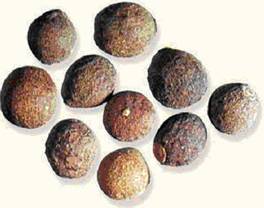NEOHESPERIDIN DIHYDROCHALCONE
Identification
Ingredient |
Neohesperidin dihydrochalcone |
Structure:
![Neosperidin dihydrochalcone , 1-(4-((2-O-[6-Deoxy-alpha-L-mannopyranosyl]-beta-D-glucopyranosyl)oxy)-2,6-dihydroxyphenyl)-3-[3-hydroxy-4-methoxyphenyl]-1-propanone CAS #: 20702-77-6 - Chemicals from China: intermediates, biochemicals, agrochemicals, flavors, fragrants, additives, reagents, dyestuffs, pigments, suppliers.](naringin-dihydrochalcone_clip_image001.gif) |
Synonyms |
Neohesperidin DHC; NHDC;Hesperetin dihydrochalcone-4’-β-neohesperidoside,Neohesperidin DC |
Molecular Formula |
C28H36O15 |
Molecular Weight |
612.58 |
CAS no. |
20702-77-6 |
EINECS |
243-978-6 |
FEMA |
3811 |
CEE no. |
E959 |
Description
Appearance: white to pale yellow powder
Solubility: in cool water is 0.4-0.5 g/l but it has high solubility in hot water, also soluble, in ethanol, water:ethanol solutions and alkaline water solutions.
Odor: Odorless
Metling point: 156.00 - 158.00 °C
Stability: very stable in crystalline form and in water solutions.
Scientific support
NHDC was discovered during the 1960s as part of a United States Department of Agriculture research program to find methods for minimizing the taste of bitter flavorants in citrus juices. Neohesperidin is one such bitter compound. When treated with potassium hydroxide or another strong base, and then catalytically hydrogenated, it becomes NHDC, a compound roughly 1500-1800 times sweeter than sugar at threshold concentrations; around 340 times sweeter than sugar weight-for-weight. Its potency is naturally affected by such factors as the application it is used for, and the pH of the product.
Like other highly sweet glycosides, such as glycyrrhizin (from the licorice root) and those found in stevia, NHDC's sweet taste has a slower onset than sugar's and lingers in the mouth for some time. Unlike aspartame, NHDC is stable to elevated temperatures and to acidic or basic conditions, and so can be used in applications that require a long shelf life. NHDC itself can stay foodsafe for up to five years when stored in optimal conditions.
The European Union approved NHDC's use as a sweetener in 1994. It has not been approved as a sweetener in the United States. It is sometimes said that NHDC is considered a Generally Recognized as Safe flavour enhancer by the Flavour and Extract Manufacturers' Association, which is a trade group with no legal standing. NHDC has never appeared on the FDA's GRAS listing. It is particularly effective in masking the bitter tastes of other compounds found in citrus, including limonin and naringin. Industrially, it is produced by extracting neohesperidin from the bitter orange, and then hydrogenating this to make NHDC.
The product is well known for having a strong synergistic effect when used in conjunction with other artificial sweeteners such as aspartame, saccharin, acesulfame potassium, and cyclamate, as well as sugar alcohols such as xylitol. NHDC usage boosts the effects of these sweeteners at lower concentrations than would otherwise be required; smaller amounts of other sweeteners are needed. This provides a cost benefit.
As a flavour enhancer, NHDC is used in a wide range of products and is indicated by the E number E 959. It is noted particularly for enhancing sensory effects (known in the industry as 'mouth feel.') An example of this is 'creaminess' in dairy foods such as yogurt and ice cream but is also widely favoured for use in otherwise naturally bitter products. Pharmaceutical companies are fond of the product as a means of reducing the bitterness of pharmacological drugs in tablet form and it has been used for livestock feed as a means of reducing feeding time. Other products NHDC can be found in may include a wide variety of alcoholic beverages (and non-alcoholic), savoury foods, toothpaste, mouthwash and condiments such as ketchup and mayonnaise.
Application
1. Soft drink
Fruit drink, Carbonated drink, still drinks, Powdered drink concentrate, syrups,sports drink, dark sweet beer, ice tea, grapefruit juice, cola drink, citrus drink, juices, milk and derivatives, water based flavoured drinks, alcoholic drinks.
Dosage: 10-30 ppm( sweetener) , 1-5 ppm ( Flavor enhancer)
2. Chewing gum
Dosage: 400 ppm( sweetener), 1-5 ppm( Flavor enhancer)
3. Dairy products & desserts:
Chocolate based products, spreads, yoghourt, ice-creams.
Dosage: 10-35 ppm ( sweetener) , 1-5 ppm( flavor enhancer)
4. Confectionery
Chocolate based products, dry fruits, spreads, marmalades, jams, jelly, sweets, cider, fruit preserves, bakery, low calorie food.
Dosage : 15-50 ppm( sweetener), 1-5 ppm(Flavor enhancer)
5. Spice flavor
Sauces, pat condiments, seasonings, mayonnaise, soups, fish.
Dosage: 1-5 ppm( Flavor enhancer)
6. Pharmaceutical industry
Maskering bitter taste.
Dosage: 10-30 ppm( sweetener) , 1-5 ppm( flavor enhancer)
7. Cosmetics:
Tooth-paste, mouth-wash.
8. Animal feed industry:
Pet foods, veterinary products, vitamin and mineral preparations, feed stuffs for farm animals , and special feedstuff for young animals.
Dosage: 1-5 ppm(Flavor enhancer)
Legislation
Food:
Common Market: CEE No. E-959 See files: 94/35/EC (english) (dosis) and
95/31/EC (english), 2106/1996 (spanish), 2001/30/CE (spanish), SCO/1050/2002 (spanish) (for the purity of Neohesperidin Dihydrochalcone) and 96/83/EC
USA. FEMA/GRAS: 3811
Pharmacy:
European Pharmacopoeia 4rd Edition - E 959
Feed:
COUNCIL DIRECTIVE 70/524/EEC (english) and see file: 97/6/CE (french) (dosis)
Regulations 1991
Authorized Daily Dose: COM/2001-DDA 5mg/kg
World Health Organization: Codex Alimentarius
Documents available
For different application, following documents are available upon customer’s requirement.
--- Specification sheet
--- Material Safety Date Sheet
--- Typical Certificate of analysis
--- FAMI-QS
--- Health certificate
--- Kosher certificate
Availability
Commercial neohesperidin dihydrochalcone is obtained by chemical synthesis from Naringin or Neohesperidin which exist largely in Citrus fruits.

Dried immature citrus fruit.
Warning:
Above information is only knowledge,not an instruction of usage for this product. The owner of this webiste should not be responsible for any damage because of misuse of the product. |



